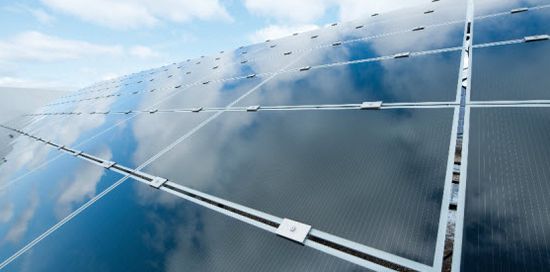Acrylic materials have a role in photovoltaics too: PMMA from Evonik Röhm is already proven for outdoor applications from automotive glazing to signage under the brand name Plexiglass. The light transmission properties can be adjusted to optimise solar module performance. It has been field tested, for example for more than 12 years in an Amonix concentrated PV (CPV) system, and in protection of CPV lenses for over 17 years. At Intersolar 2010, the use of Plexiglass in frontsheets was demonstrated in a lightweight module measuring 4.5 m by 1.5 m.
There are new backsheets under development including the polyolefin-based coextruded sheet from Renolit with integrated adhesive. It can also be combined with EVA as an upper encapsulant. Renolit’s waterproof membrane production has given the company extensive experience of weather-exposed polymer materials.

Many backsheets are laminates, this one is coextruded with a reactive PE face for adhesion to module components; soft encapsulating PE layers (including functional fillers like flame retardants); a connecting layer; a PP layer with high concentrations of functional fillers such as reflective pigments; a PP layer with improved heat distortion and a surface treatment or primer layer.
3M supplies adhesives to the solar module industry, such as bonding for junction boxes, cell positioning tape and acrylic foam, frame-bonding tape. It also supplies fluoropolymer backsheets, which are UL and IEC certified.
Sealing is an important aspect of module durability: moisture ingress can cause delamination, leakage of current, discoloration and corrosion. SAES Getters provides sealant tape, which can give 3000 hours of damp heat stability in thin film CIGS modules. The breakthrough time is the time required for moisture to break through the barrier sealant. Active barriers based on chemical getters have higher breakthrough times and lower permeation rates.
Encapsulation materials should be transparent, provide cushioning and impact properties, electrical insulation and a high moisture barrier. EVA is the most commonly used polymer and has been in use for over 30 years. More recently silicone rubber, PVB, ionomers and TPU have all been used as alternatives.
There are special considerations for the extrusion of encapsulant polymers, as studied by Davis-Standard. A typical EVA encapsulant has a high VA content (33%) and contains additives, which must be correctly mixed: the extruder should have a corrosion-resistant liner and screw, provide adequate torque for low temperature processing and an L/D size which balances residence time against mixing requirements.
The rise in demand for materials from the solar power industry has caused suppliers to divert materials and expand. For example, USI Corp. in Taipei is diverting EVA to the solar industry and Repsol is expanding its EVA production site in Puertollano, Spain, while in the third quarter of 2010 DuPont announced increased production of PVF in North Caroline for Tedlar film for backsheet applications.


